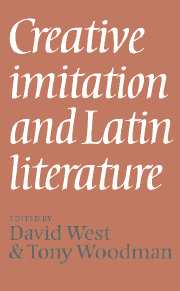Book contents
- Frontmatter
- Contents
- CONTRIBUTORS
- Prologue
- 1 DE IMITATIONE
- 2 PLAVTVS VORTIT BARB ARE: Plautus, Bacchides 526–61 and Menander, Dis exapaton 102–12
- 3 FROM POLYPHEMUS TO CORYDON: Virgil, Eclogue 2 and the Idylls of Theocritus
- 4 TWO PLAGUES: Virgil, Georgics 3.478–566 and Lucretius 6.1090–1286
- 5 HORATIAN IMITATIO AND ODES 2.5
- 6 IVDICIVM TRANSFERENDI: Virgil, Aeneid 2.469–505 and its antecedents
- 7 SELF-IMITATION WITHIN A GENERIC FRAMEWORK: Ovid, Amores 2.9 and 3.11 and the renuntiatio amoris
- 8 SELF-IMITATION AND THE SUBSTANCE OF HISTORY: Tacitus, Annals 1.61–5 and Histories 2.70, 5.14–15
- 9 LENTE CVRRITE, NOCTIS EQVI: Chaucer, Troilus and Criseyde 3.1422–70, Donne, The Sun Rising and Ovid, Amores 1.13
- 10 PYRAMUS AND THISBE IN SHAKESPEARE AND OVID: A Midsummer Night's Dream and Metamorphoses 4.1–166
- 11 EPILOGUE
- Notes
- Abbreviations and bibliography
- Select indexes
4 - TWO PLAGUES: Virgil, Georgics 3.478–566 and Lucretius 6.1090–1286
Published online by Cambridge University Press: 12 March 2010
- Frontmatter
- Contents
- CONTRIBUTORS
- Prologue
- 1 DE IMITATIONE
- 2 PLAVTVS VORTIT BARB ARE: Plautus, Bacchides 526–61 and Menander, Dis exapaton 102–12
- 3 FROM POLYPHEMUS TO CORYDON: Virgil, Eclogue 2 and the Idylls of Theocritus
- 4 TWO PLAGUES: Virgil, Georgics 3.478–566 and Lucretius 6.1090–1286
- 5 HORATIAN IMITATIO AND ODES 2.5
- 6 IVDICIVM TRANSFERENDI: Virgil, Aeneid 2.469–505 and its antecedents
- 7 SELF-IMITATION WITHIN A GENERIC FRAMEWORK: Ovid, Amores 2.9 and 3.11 and the renuntiatio amoris
- 8 SELF-IMITATION AND THE SUBSTANCE OF HISTORY: Tacitus, Annals 1.61–5 and Histories 2.70, 5.14–15
- 9 LENTE CVRRITE, NOCTIS EQVI: Chaucer, Troilus and Criseyde 3.1422–70, Donne, The Sun Rising and Ovid, Amores 1.13
- 10 PYRAMUS AND THISBE IN SHAKESPEARE AND OVID: A Midsummer Night's Dream and Metamorphoses 4.1–166
- 11 EPILOGUE
- Notes
- Abbreviations and bibliography
- Select indexes
Summary
Virgil's account of a cattle plague at the end of the third book of the Georgics draws heavily upon Lucretius' account of the plague at Athens which ends the sixth and last book of the De rerum natura. The purpose of this essay is to throw light upon the Virgilian passage by comparing it with the Lucretian.
THE AETIOLOGY
Hie quondam morbo caeli miseranda coorta est
tempestas totoque autumni incanduit aestu
et genus omne neci pecudum dedit, omne ferarum,
corrupitque lacus, infecit pabula tabo.
(Virgil, Georgics 3.478–81)Here once, through a disease of the sky, there arose a pitiable season which burned with heat for a whole autumn, giving over to death all manner of livestock and all manner of wild beasts, polluting their drinking water and poisoning their food with decomposing flesh.
As a clinical history this is not satisfactory. What is the tempestas which arose? Season? Time? Commotion? Calamity? And how coorta? Arisen from the ground? or gathered somehow in the air? And how is it helpful to say that a cattle plague arose because of a disease of the sky? This is little more than a metaphor and it is followed by another, when Virgil says that the season burned throughout the heat of a whole autumn. And what is the tabum which infected the food and water? It could perhaps refer to the plague with which the season infected the drink and food of animals. But the usual meaning of tabum is ‘decaying gore or tissue’, and on that explanation a more satisfactory chronology is given: in 1. 480 the season kills the animals and then (through their corpses) infects their food and drink.
- Type
- Chapter
- Information
- Creative Imitation and Latin Literature , pp. 71 - 88Publisher: Cambridge University PressPrint publication year: 1979
- 17
- Cited by



